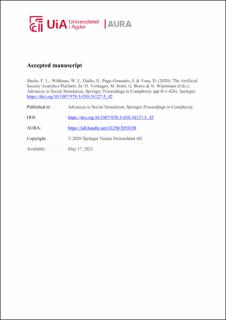| dc.contributor.author | Shults, Fount LeRon | |
| dc.contributor.author | Wildman, Wesley J. | |
| dc.contributor.author | Diallo, Saikou | |
| dc.contributor.author | Puga-Gonzalez, Ivan | |
| dc.contributor.author | Voas, David | |
| dc.date.accessioned | 2023-03-14T13:25:40Z | |
| dc.date.available | 2023-03-14T13:25:40Z | |
| dc.date.created | 2020-07-29T14:14:32Z | |
| dc.date.issued | 2020 | |
| dc.identifier.citation | Shults, F. L., Wildman, W. J., Diallo, S., Puga-Gonzalez, I. & Voas, D. (2020). The Artificial Society Analytics Platform. In: H. Verhagen, M. Borit, G. Bravo & N. Wijermans (Eds.), Advances in Social Simulation, Springer Proceedings in Complexity (pp 411-426). Springer. | en_US |
| dc.identifier.isbn | 978-3-030-34127-5 | |
| dc.identifier.issn | 2213-8692 | |
| dc.identifier.uri | https://hdl.handle.net/11250/3058198 | |
| dc.description | Author's accepted manuscript | en_US |
| dc.description.abstract | Social simulation routinely involves the construction of artificial societies and agents within such societies. Currently there is insufficient discussion of best practices regarding the construction process. This chapter introduces the artificial society analytics platform (ASAP) as a way to spark discussion of best practices. ASAP is designed to be an extensible architecture capable of functioning as the core of many different types of inquiries into social dynamics. Here we describe ASAP, focusing on design decisions in several key areas, thereby exposing our assumptions and reasoning to critical scrutiny, hoping for discussion that can advance debate over best practices in artificial society construction. The five design decisions are related to agent characteristics, neighborhood interactions, evaluating agent credibility, agent marriage, and heritability of personality. | en_US |
| dc.language.iso | eng | en_US |
| dc.publisher | Springer | en_US |
| dc.relation.ispartofseries | Springer Proceedings in Complexity; | |
| dc.subject | Agent-based Modelling | en_US |
| dc.title | The Artificial Society Analytics Platform | en_US |
| dc.type | Chapter | en_US |
| dc.type | Peer reviewed | en_US |
| dc.description.version | acceptedVersion | en_US |
| dc.rights.holder | © 2020 Springer Nature Switzerland AG | en_US |
| dc.subject.nsi | VDP::Samfunnsvitenskap: 200::Urbanisme og fysisk planlegging: 230 | en_US |
| dc.subject.nsi | VDP::Samfunnsvitenskap: 200 | en_US |
| dc.source.pagenumber | 411-426 | en_US |
| dc.identifier.doi | https://doi.org/10.1007/978-3-030-34127-5_42 | |
| dc.identifier.cristin | 1820931 | |
| dc.relation.project | Norges forskningsråd: 250449 | en_US |
| cristin.qualitycode | 1 | |
